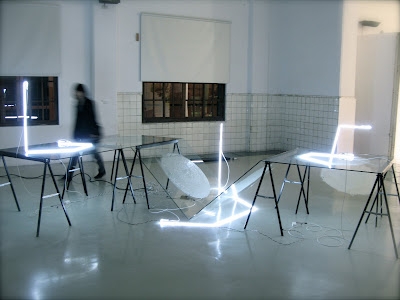Dec 16, 2011
Nov 8, 2011
Sep 23, 2011
Jul 10, 2011
Jun 13, 2011
Jun 12, 2011
The Empty City at glogauair in Berlin
 |
THE EMPTY CITY June-24 - July 3, 2011 Opening : June 24, Friday, 8pm Venue: GlogauAIR Glogauerstr.16, 10999 Berlin 許家維 China-Wei Hsu 余政達 Cheng-Ta Yu 張怡貞 Yi-Chen Chang 吳佩珊 Pei-Shan Wu 王榆鈞 Yu-Jun Wang Opening Performance Yu-Jun Wang Hui-Chen Lin + Max Loeb Organized by IDOLONSTUDIO - www.idolonstudio.com Cooperation Space by GlogauAIR - www.glogauair.net Support by National Culture and Arts Foundation - www.ncafroc.org.tw The Empty City, No One’s Left Cities are the result of humanity, they seem to be half organic, continuously growing over time. The significance of the city extends from the center to the edge. The edge then becomes the center, forming a new edge. Due to its intricate structure, the history of a city is constantly in transition. However, like an organism, cities also age, die, and are reborn. Because of the rapid rate of change, there is not enough time for the organism to create a new shell. Once a city has become a ghost town, it also becomes a statement on contemporary human landscape. Perhaps the landscape was influenced by migrations, whether natural or because of war. These spatial transfigurations, both surreal and metaphysical, provide distinctive perspectives on culture. The exhibition “The Empty City” reflects the artist‘s concern for urban life – its interpretation and reflection – by viewing the city through a series of metaphors from the summer solstice. |
May 14, 2011
Derailment in Taichung at Stock 20
 |
| More Information Please check on URL: Derailment |
Apr 26, 2011
當代藝術策展與公共空間資本化工作坊 in Tainan
 |
| More Information Please check on URL: TNNUA ATC |
Mar 16, 2011
關於光距再思考
Mar 1, 2011
Feb 23, 2011
Post-lighting Era,Taichung at Stock 20
Post-lighting Era Humans used torches, candles, and kerosene to shield themselves against darkness in the mythological age. Lighting brings security, elongates time, and expands space for people’s use. In other words, we could say that lighting has been a pioneer of civilization. It was not until Edison invented light bulbs that human strode into a brand new era. In this period, artificial illuminations have been widely used in daily life and have become an essential device for communication, care, and management. These new varieties of lighting have changed the way human organize the society and enhanced the development and transmission of culture.In the age of technological advancements, lighting gradually develops as a specialized language. The establishment of various lighting skills allows artists to manipulate lights to express nuanced messages, atmosphere or implicit connotations.It is impossible to leave out the presentation of light when we discuss the use of lighting. In western art history, lighting or light represents specific perspectives. Artists in the medieval time often expressed warmth or divinity with lighting in darkness. For example, Da Vinci, an artist of the Renaissance, gave The Last Supper a natural and rational lighting while employed sfumato techniques to create the romantic halo in Mona Lisa. In the baroque era, Caravaggio used theatrical lighting to capture the transient nature of human’s emotional changes. Monet, an artist of Impressionism, embraced nature and analyzed the enigmatic light by dissecting it into colorful spots in order to tell people that there is no complete black in the world. In contemporary art, lighting devices have shifted from a tool for display to an integrated part of artworks. Self-illumination becomes a strong pronouncement for self-identity. When creators give artists the right to illuminate, as if light conveys the messages from God, lightings within art attract all living organisms’ nature of phototaxis, This exhibition invites Chaong-Wen TING, Chingfong LIN, I-Chen KUO and Alex CHENG to reveal the possibilities of lighting as a language in the Post- lighting Era. 人類從神話時代就開始抵禦黑暗,從火把、燭光到煤油燈,光亮帶來安全、帶來可供利用的時間與空間,我們可以說,照明一直是文明發展的先鋒。一直到了愛迪生發明電燈,人類的照明,開始進入了一個全新的時代。在這個時期,人工照明被大量帶入生活當中,進而成為社會系統裡不可或缺的傳達、照護、甚至管理者,新型態的照明,達成了城市的發展與拓延等種種目的。 如今,在科技不斷創新的今日,照明,逐漸發展成為一種專門的語彙,在多種類型的照明技術建構下,藝術家開始利用它們展現細微的訊息、氛圍或隱藏的寓言。我們將在這檔展覽當中,一一揭示各種後照明時代,照明語彙的可能性。 |
Feb 18, 2011
Feb 14, 2011
Jan 16, 2011
We cut the paper, and cut our nervousness into the washing machine
Jan 4, 2011
Subscribe to:
Posts (Atom)


















